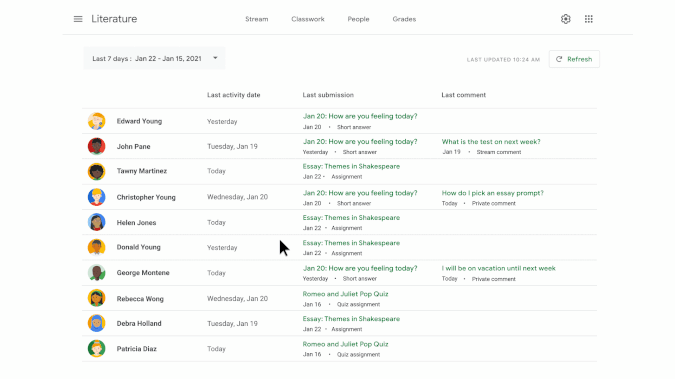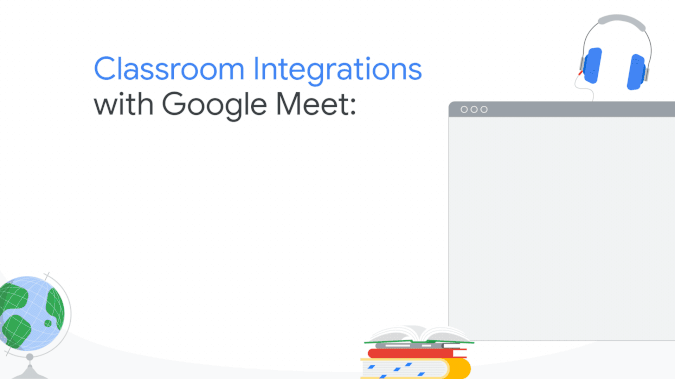School attendance has never been as dependent on technology as it is today. Classrooms have become virtual, parents have become more engaged, and teachers have become more familiar with video conferencing platforms than ever. Google today announced a range of educational tools designed to improve existing learning products and make it easier for students and teachers to navigate the online school.
Classroom
The majority of these updates will be provided to the Company’s Classroom Service, which is a dashboard (or “learning management system”) for teachers and students. The Android app will have better offline support later this year, so students can start their work, open drive attachments, review and write assignments without an internet connection. Photo uploading is also being improved in the Android app, allowing students to combine photos into a single document, adjust lighting, crop and rotate their pictures. When you use Classroom to complete your assignments, whether on the web, iOS, or Android, you can quickly add bold, italic, and underlined words, and bullets. Google is also launching a free introductory computer science course called CS First, which is available now.
To help teachers spot potential plagiarism, Google is also adding “Originality Reports” in new languages such as Spanish, Portuguese, Norwegian, French, Italian, Indonesian, Japanese, Finnish, German, Korean, Malay, and Hindi. Later this year, educators reviewing assignments on Android can also switch between submissions from different students while viewing an assignment and providing feedback. There will also be a new feature to track student engagement, which will show statistics about which students have submitted assignments and which posts have commented. Administrators can quickly get monitoring and activity logs to better understand what happened when the system went down.
Those using existing educational frameworks such as a Student Information System (SIS) will be able to better integrate the classroom with these services later this year. Grade export, for example, comes into the Aspen SIS and allows teachers to export students’ grades from the classroom to the SIS, which should reduce redundant data entry. You can also populate and synchronize class and roster information with Classroom.
To meet
Google announced some educational improvements to its video chat service at its Anywhere School event in August. However, today we announced new administrative tools for teachers. First, teachers can quickly end meetings for all participants, even in breakout rooms. You also have the option to mute all attendees in the coming weeks, and in April you can also control when students can unmute. Moderation controls such as screen sharing, chat access, and granting access to the meeting will also be available on mobile devices for teachers in the coming months.
Meet also works better with Classroom by pulling roster information so only students and teachers in each class can attend the appropriate meetings. Every Classroom Approved Teacher is given host status so they can help manage the class. Later this year, meet sessions started outside of the classroom can also support multiple hosts. In a few weeks, teachers can also set up breakout rooms in advance in a meet session and receive copies of the meeting minutes. Students can also choose skin tones when using emojis to respond in class (teachers can control whether emoji reactions are enabled).
In April, the company added new settings to the Admin Console to allow school principals to set policies such as: For example, who can participate in calls hosted by their school and whether they should be allowed to join meetings from other schools. Administrators now also have access to audit logs. More information, such as external participant email addresses, will be added to them shortly to help investigate problems.
Work area for education
Google also announced a new Workspace for Education, basically renamed G Suite for Education. Instead of offering just two options (Education Fundamentals and Plus), the company will add an Education Standard version and a teaching and learning upgrade starting April 14th. Those who already have G Suite For Enterprise For Education (what a name) will soon see the new name Education Plus on their consoles and get all of that top-level functionality. Workspace For Education also introduces new features, including meeting minutes and saved drafts in Google Forms (availability depends on the version of the service you are using).
One thing to note is that Google is eliminating free unlimited storage for qualified schools and universities. According to the company, memory usage has “increased rapidly to serve more schools and universities each year” and “memory is not being fairly consumed within or within institutions”. The company is therefore switching to a new pool storage model that it says will affect less than 1 percent of institutions. All institutions now receive 100 TB of pooled cloud storage that is shared by all users. It will come into effect for existing customers in July 2022 and apply immediately to those who register in the next year.
Users don’t need to do anything, it seems like this change is automatic. Google will contact affected institutions in the coming weeks to discuss storage options that may be required. According to the company, 170 million students and educators worldwide use Workspace for Education. Classroom now serves over 150 million users worldwide, up from 40 million a year ago. The need for distance learning tools has grown significantly during this time, and Google’s focus on this area could help make learning a little easier for students, teachers, and parents.


